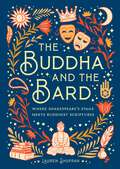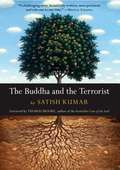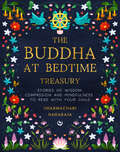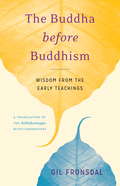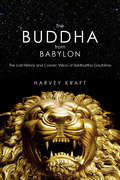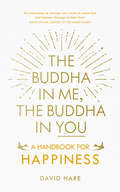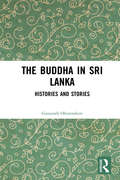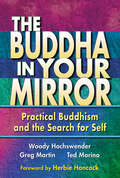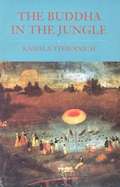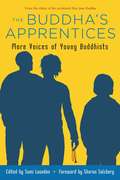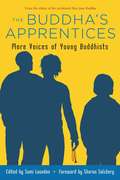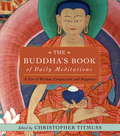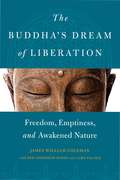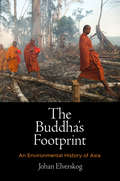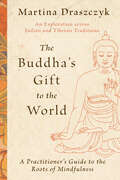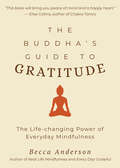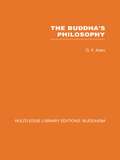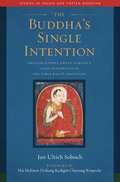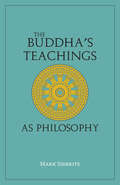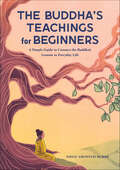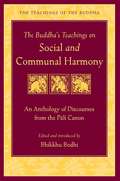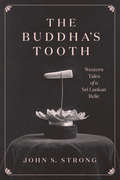- Table View
- List View
The Buddha and the Bard
by Lauren ShufranWhat does Shakespeare have to teach us about mindfulness? What Eastern spiritual views about death, love, and presence are reflected in the writings of The Bard? The Buddha and the Bard reveals the surprising connections between the 2,500-year-old spiritual leader and the most compelling writer of all time. &“Shufran&’s compelling juxtapositions will encourage the reader to ask the deepest questions of themselves while delighting in the play of resonances across a cultural and historical divide.&” – YOGA Magazine Shakespeare understood and represented the human condition better than any writer of his time. As for the Buddha, he saw how to liberate us from that condition. Author Lauren Shufran explores the fascinating interplay of Western drama and Eastern philosophy by pairing quotes from Shakespeare with the tenets of an Eastern spiritual practice, sparking a compelling dialogue between the two. There&’s a remarkable interchange of echoes between Shakespeare&’s conception of &“the inward man&” and Buddhist approaches to recognizing, honoring, and working with our humanness as we play out our roles on the &“stage&” of our lives. The Buddha and the Bard synthesizes literature and scripture, embodied drama and transcendent practice, to shape a multifaceted lyric that we can apply as mindful practice in our own lives. Shufran&’s compelling juxtapositions will encourage the reader to ask the deepest questions of themselves while delighting in the play of resonances across a cultural and historical divide.
The Buddha and the Terrorist
by Thomas Moore Satish Kumar Allan Hunt BadinerInternational terrorism may have become the central specter of our time, but the threat of violence is as old as history. Among all the experiences of the Buddha, perhaps this story of his eye-to-eye encounter with a fearsome terrorist is the one most relevant and vital for us today. What happens when a man committed to violence is confronted by a man committed to nonviolence? Who is more powerful? Who can influence whom? The Buddha, Jesus Christ, Mahatma Gandhi, Martin Luther King Jr., the Dalai Lama, have all sought to inspire us. Satish Kumar's retelling of the ancient Buddhist tale of transformation speaks to the possibility of changing the world. This small book contains an unassailable spiritual and practical message and inspired guidance in the use of nonviolent resistance in the quest for lasting peace. The Buddha's approach is one of engagement and dialogue--even toward those with whom he disagrees. No one can read this tale without thinking about the root causes of terrorism, about good and evil, about justice and forgiveness, about the kind of place we want the world to be, and about the most productive and practical way to get there.
The Buddha at Bedtime Treasury: Stories of Wisdom, Compassion and Mindfulness to Read with Your Child
by Dharmachari NagarajaA gift edition treasury of over 50 stories from the Buddha at Bedtime books, ancient Buddhist tales retold for children alongside summaries and meditations.Discover over 50 magical retellings of ancient Buddhist storiesBuilding on the age-old art of storytelling, this beautifully illustrated treasury brings together tales from three classic collections: Buddha at Bedtime, The Buddha's Apprentice at Bedtime and Calm Buddha at Bedtime.Transport your child into a world of enchantment and uncover easy-to-understand Buddhist messages through the adventures of delightful characters like the Brave Little Parrot, the Gentle Dragon or the Grateful Bull. In addition to these stories, you will find lessons on the art of meditation, advice on how to become more mindful and a selection of soothing, guided visualizations.Make this book a part of your regular bedtime routine and give your child the tools they need to be calm and relaxed before sleep and as they go about their day.
The Buddha before Buddhism: Wisdom from the Early Teachings
by Gil FronsdalIn the tradition of the best-selling Dhammapada: a translation with commentary of one of the earliest of the surviving Buddhist texts, which reveals the teachings to be remarkably simple and free of religious trappings. One of the earliest of all Buddhist texts, the Atthakavagga, or "Book of Eights," is a remarkable document, not only because it comes from the earliest strain of the literature--before the Buddha, as the title suggests, came to be thought of as a "Buddhist"--but also because its approach to awakening is so simple and free of adherence to any kind of ideology. Instead the Atthakavaggapoints to a direct and simple approach for attaining peace without requiring the adherence to doctrine. The value of the teachings it contains is not in the profundity of their philosophy or in their authority as scripture; rather, the value is found in the results they bring to those who live by them. Instead of doctrines to be believed, the Book of Eights describes means or practices for realizing peace. Gil Fronsdal's rigorous translation with commentary reveals the text to be of interest not only to Buddhists, but also to the ever-growing demographic of spiritual-but-not-religious, who seek a spiritual life outside the structures of religion.
The Buddha from Babylon
by Harvey KraftThe sudden death of the Persian Emperor in 522 BCE is one of history's great mysteries. Was his demise self-inflicted, accidental, an assassination, or due to natural causes? The author contends that during this incident Siddhartha Gautama may have been the leader of Babylon's Magi, an interfaith order that assumed governance of the region. The situation exploded when Darius the Great seized the throne. Simultaneously the Magi Order was purged as Siddhartha, prince of the Saka nation headed back east to the Indus. Could this event have inspired the creation of Buddhism as a pacifist movement dedicated to the pursuit of self-transformation, goodwill, and universal compassion? The Buddha from Babylon: The Lost History and Cosmic Vision of Siddhartha Gautama uncovers new evidence that solves this age-old mystery and discovers Babylonian influences in the Buddha's revelations. The Buddha from BabylonL The Lost History and Cosmic Vision of Siddhartha Gautama is a double winn er of the USA Best Book Awards for (World) History-Non-Fiction and for Eastern Non-Fiction books.
The Buddha from Babylon: The Lost History and Cosmic Vision of Siddhartha Gautama
by Harvey KraftThe sudden death of the Persian Emperor in 522 BCE is one of history's great mysteries. Was his demise self-inflicted, accidental, an assassination or due to natural causes? The author contends that during this incident Siddhartha Gautama may have been the leader of Babylon's Magi, an interfaith order that assumes governance of the region. The situation explodes when Darius the Great seizes the throne. Simultaneously the Magi Order is purged as Siddhartha, prince of the Saka nation, heads back east to the Indus. Could this event have inspired the creation of Buddhism as a pacifist movement dedicated to the pursuit of self-transformation, goodwill, and universal compassion? The Buddha from Babylon: The Lost History and Cosmic Vision of Siddhartha Gautama uncovers new evidence that solves this ages-old mystery and discovers Babylonian influences in the Buddha's revelations.
The Buddha in Me, The Buddha in You: A Handbook for Happiness
by David HareDo you want to be happier? Find inner calm? Enjoy a rich and rewarding life? Here's how... The Buddha in Me, the Buddha in You combines the tried-and-tested wisdom of Nichiren Buddhism with the best of popular psychology and personal development, making this a brilliant guide to how life works, and how to get the most from it. Nichiren Buddhism differs from other Buddhist schools in its focus on the here-and-now, and places great importance on individual growth as the starting point for a better world. This, combined with powerful techniques such as NLP, mindfulness, journalling and coaching, makes The Buddha in Me, the Buddha in You the quintessential handbook for happiness.'Buddha' simply means someone who is awakened - yet while Nichiren Buddhists will find fascinating insights into their practice, there is no need to follow a spiritual path to benefit from this book. Through his experience as an internationally acclaimed life coach and practising Buddhist, author David Hare shows us how to wake up to our own potential and that of those around us – to discover everyday enlightenment.
The Buddha in Sri Lanka: Histories and Stories
by Gananath ObeyesekereThis book examines culture, religion and polity in the context of Buddhism. Gananath Obeyesekere, one of the foremost analytical voices from South Asia develops Freud’s notion of ‘dream work’, the ‘work of culture’ and ideas of no-self (anatta) to understand Buddhism in contemporary Sri Lanka. This work offers a restorative interpretation of Buddhist myths in contrast to the perspective involving deconstruction. The book deals with a range of themes connected with Buddhism, including oral traditions and stories, the religious pantheon, philosophy, emotions, reform movements, questions of identity and culture, and issues of modernity. This fascinating volume will greatly interest students, teachers and researchers of religion and philosophy, especially Buddhism, ethics, cultural studies, social and cultural anthropology, Sri Lanka and modern South Asian history.
The Buddha in Your Mirror: Practical buddhism and the Search for Self
by Greg Martin Woody Hochswender Ted MorinoWhile the notion that "happiness can found within oneself" has recently become popular, Buddhism has taught for thousands of years that every person is a Buddha, or enlightened being, and has the potential for true and lasting happiness. Through real-life examples, the authors explain how adopting this outlook has positive effects on one’s health, relationships, and career, and gives new insights into world environmental concerns, peace issues, and other major social problems.
The Buddha in the Jungle
by Kamala TiyavanichA Thai Buddhist and US-trained historian, Tiyavanich weaves together stories about Siam in the 19th and early 20th centuries that illuminate the life of the Buddhist culture. They tell of village monks encountering giant snakes, a Christian missionary gored by an elephant, bandits and boatmen, a dog-bodhisattva, midwives, guardian spirits, and other topics. Distributed in the US by the University of Washington Press. Annotation ©2004 Book News, Inc. , Portland, OR (booknews. com)
The Buddha's Apprentices: More Voices of Young Buddhists
by Sharon Salzberg Sumi LoundonSumi Loundon's Blue Jean Buddha was hailed by the New York Times Review of Books as "a bellwether anthology"--mapping the spiritual trails followed by a generation of American Buddhist youths. The Buddha's Apprentices examines that territory in fuller detail, telling twenty-six more stories of this powerful spiritual path, including the stories of many teenagers. The book shows us the common challenges that spiritually hungry young adults of today might face, with a focus on the identity issues around personality, profession, and lifestyle. Also included are several affirming essays from prominent older Buddhists, recalling their first encounters with Buddhism. The Buddha's Apprentices inspires, examining the tectonic shifts that young, spiritually-inclined people undergo as they leave home, search for partners, consider commitment and marriage, and build their lives. Furthermore, they tell of how Buddhism changes and enhances their abilities to face life's difficulties. Sumi Loundon's rich and youthful commentary lets us appreciate each contributor's individual voice, and helps us to see how they contribute to the always-evolving chorus of modern Buddhism. The Buddha's Apprentices can be considered a sequel to Sumi Loundon's Blue Jean Buddha, but goes beyond that work by giving extra attention to teens and young adults and including pieces from Thich Nhat Hanh, Lama Surya Das, and a truly diverse array of younger author/contributors.
The Buddha's Apprentices: More Voices of Young Buddhists
by Sumi D. LoundonThe Buddha's Apprentices explores that territory in greater detail, telling 27 more stories from young Buddhists, including teenagers, and prominent older Buddhist teachers looking back on their own youth.
The Buddha's Book of Daily Meditations
by Christopher TitmussThe Buddha taught a down to earth wisdom. Even though he lived 2500 years ago, his teachings remain deeply relevant. Through reflecting on the Buddha's thoughts and advice, we will open our minds to frest insights. We may begin to shake off our conditioning and to make revolutionary changes in our personal, social, political and spiritual lives. In The Buddha's Book Of Daily Meditcations, world renowned meditation master Christopher Titmuss has chosen inspiring translations of the Buddhist suttras for each day of the year. These words of the Buddha show such depth of experience and understanding that, if we meditate on them on a regular basis, we cannot fail to make significant steps towards enlightenment.
The Buddha's Dream of Liberation: Freedom, Emptiness, and Awakened Nature
by Reb Anderson James William Coleman Lama PaldenExplore the three great teachings of the Buddha with this plain-English primer• The First Turning of the Wheel: Insight into the nature of suffering—and the way out of it—from the four noble truths and the eightfold path • The Second Turning of the Wheel: Teachings on emptiness from the Heart Sutra and the Diamond Sutra • The Third Turning of the Wheel: Guidance for practitioners and teachings on awakened Buddha nature In clear language, James William Coleman, professor of sociology at the California Polytechnic State University, guides us through the ancient sutras that preserve the Buddha’s message, illuminating their meaning for today’s world and tying the Buddha’s wisdom together for us. The book concludes with chapters from two great teachers, Reb Anderson from the Zen tradition and Lama Palden from the Tibetan Buddhist tradition, on how to use meditation to bring the Buddha’s wisdom into our daily lives. Table of Contents: Introduction: The Wheel of Dharma Part I: The Three Turnings of the Wheel 1. The First Turning of the Wheel: The Four Noble Truths and the Pali Canon 2. The Second Turning of the Wheel: Emptiness and the Perfection of Wisdom 3. The Third Turning of the Wheel: Untying the Knot of the Sutra of the Explanation of the Profound Secrets Part II: Turning the Wheel in the Twenty-First Century 4. Practicing the Dream 5. Tasting the Truth of the Buddha’s Words: A Zen Perspective by Reb Anderson Roshi 6. Envisioning Tara: A Vajrayana Perspective by Lama Palden Drolma 7. The Buddha’s Dream
The Buddha's Footprint: An Environmental History of Asia (Encounters with Asia)
by Johan ElverskogIn the current popular imagination, Buddhism is often understood to be a religion intrinsically concerned with the environment. The Dharma, the name given to Buddhist teachings by Buddhists, states that all things are interconnected. Therefore, Buddhists are perceived as extending compassion beyond people and animals to include plants and the earth itself out of a concern for the total living environment. In The Buddha's Footprint, Johan Elverskog contends that only by jettisoning this contemporary image of Buddhism as a purely ascetic and apolitical tradition of contemplation can we see the true nature of the Dharma. According to Elverskog, Buddhism is, in fact, an expansive religious and political system premised on generating wealth through the exploitation of natural resources.Elverskog surveys the expansion of Buddhism across Asia in the period between 500 BCE and 1500 CE, when Buddhist institutions were built from Iran and Azerbaijan in the west, to Kazakhstan and Siberia in the north, Japan in the east, and Sri Lanka and Indonesia in the south. He examines the prosperity theology at the heart of the Dharma that declared riches to be a sign of good karma and the means by which spritiual status could be elevated through donations bequeathed to Buddhist institutions. He demonstrates how this scriptural tradition propelled Buddhists to seek wealth and power across Asia and to exploit both the people and the environment.Elverskog shows the ways in which Buddhist expansion not only entailed the displacement of local gods and myths with those of the Dharma—as was the case with Christianity and Islam—but also involved fundamentally transforming earlier social and political structures and networks of economic exchange. The Buddha's Footprint argues that the institutionalization of the Dharma was intimately connected to agricultural expansion, resource extraction, deforestation, urbanization, and the monumentalization of Buddhism itself.
The Buddha's Gift to the World: A Practitioner's Guide to the Roots of Mindfulness
by Martina DraszczykAn original presentation of the history and practice of mindfulness drawn from the teachings of eminent Mahayana Buddhist masters.Until now, mindfulness in the West has mainly been taught and practiced based on the Theravada Buddhist tradition. This book offers the first comprehensive exploration of the subject based on Mahayana Buddhist sources, including a number of the Buddha&’s discourses and treatises and texts by eminent Indian and Tibetan Buddhist masters. With its emphasis on theory and practice, this book will be rewarding for anyone interested in mindfulness, meditation, and the history and practice of Indian and Tibetan Buddhism.Martina Draszczyk balances rigorous scholarship with her decades of experience as a Dharma and mindfulness teacher to guide readers through this vast subject. She conveys how mindfulness intersects and diverges in Mahayana and Theravada Buddhism and offers insight into how Buddhist-inspired mindfulness is applied in contemporary non-Buddhist contexts, such as the Mindfulness-Based Stress Reduction program (MBSR). This book&’s exploration of mindfulness from a previously overlooked perspective complements other publications on the subject and provides readers with a more complete understanding of the role mindfulness plays in Buddhist practice beyond the current trend of enhancing relaxation and calm. Draszczyk shows readers how to integrate the wisdom of classical teachings into their own mindfulness practice. Readers can find further inspiration in the elucidation on the fourfold application of mindfulness given by the Fourteenth Shamar Rinpoche, a great Kagyu teacher. This teaching, which he shared in 2014 only weeks before his passing, can lead to a truly profound Buddhist practice.
The Buddha's Guide to Gratitude: The Life-changing Power of Everyday Mindfulness
by Becca AndersonHow to shift the “focus on what is right in our lives instead of what is missing . . . This book is a guide to increasing your happiness quotient” (Nina Lesowitz, author of Living Life as a Thank You).As it turns out, Buddha had quite a lot to say on the subject of gratitude, including citing it as one of the four keys to the Gate of Heaven. Studies show?and experts counsel?that gratitude is a key component of our happiness. People who are grateful about events and experiences from the past, who celebrate triumphs instead of focusing on losses or disappointments, tend to be more satisfied. Gratitude can help us transform our fears into courage, our anger into forgiveness, our isolation into belonging, and another’s pain into healing. Even in the midst of over-busyness, stress, and chaos, we can find plenty to be glad about, and this book will start your journey towards Zen and gratefulness.The Buddha’s Guide to Gratitude provides you with positive thinking “power tools” that will help you build a more grateful life, including:Mindful meditationsHands-on exercisesProfound practicesInspiring quotationsSpace for notetaking and journalingThought-provoking questions“This book will bring you peace of mind and a happy heart.” —Elise Collins, author of Chakra Tonics“Practicing gratitude is like taking your vitamins?you don’t just take them when you’re sick; you also have to take them to stay healthy.” —Louise Baxter Harmon, author of Happiness A-Z“The most magnetic trait of all time is gratitude! Want to transform your outlook and your life, read and enjoy The Buddha’s Guide to Gratitude.” —Susannah Seton, author of Simple Pleasures
The Buddha's Philosophy: Selections from the Pali Canon and an Introductory Essay (Routledge Library Editions: Buddhism)
by G F AllenThis study, originally published in 1959, traces the origin of Buddhism in Brahmanism, and fixes its relationship to Hinduism, describing and stressing the basic importance of Buddhist contemplation. The first half of the book introduces the very heart of Buddhism, while the second part presents the Teaching itself, as handed down in the canonical writings of the ancient East.
The Buddha's Single Intention: Drigung Kyobpa Jikten Sumgön's Vajra Statements of the Early Kagyü Tradition (Studies in Indian and Tibetan Buddhism)
by Jan-Ulrich SobischThe definitive presentation of one of the most unique and compelling works of classical Tibetan literature.This book presents an influential and extraordinary teaching of the Kagyü tradition of Tibetan Buddhism known as the Single Intention by the master Drigung Jikten Sumgön (1143–1217), along with its chief commentaries, principally the Light of the Sun by Rikzin Chökyi Drakpa (1595–1659). Early in the history of the Kagyü school, the teachings of Jikten Sumgön were condensed into 150 core formulations called vajra statements. These pithy, revelatory statements comprise the Single Intention (Dgongs gcig), which presents the thought of the Buddha and the nature of the ineffable (brjod du med pa) in concise and direct expression. The Single Intention weaves the thread of ineffable mahamudra through the entire fabric of Buddhism. It presents mahamudra as pervading disciplined conduct, meditative concentration, and discriminative knowledge; ground, path, and result; view, practice, and conduct; and the &“three vows&” of pratimoksa, of the bodhisattvas, and of mantra. Jikten Sumgön teaches how the fundamental values and insights revealed by the Buddha are woven into reality and therefore accessible to all. Jan-Ulrich Sobisch manages to convey the unity of the Buddha&’s message both in its particulars and in its scope. His deep and authoritative skill makes this the definitive presentation of one of the most unique and compelling works of classical Tibetan literature.
The Buddha's Teachings As Philosophy
by Mark SideritsA shorter and less technical treatment of its subject than the author&’s acclaimed Buddhism As Philosophy (second edition, Hackett, 2021), Mark Siderits's The Buddha&’s Teachings As Philosophy explores three different systems of thought that arose from core claims of the Buddha. By detailing and critically examining key arguments made by the Buddha and developed by later Buddhist philosophers, Siderits investigates the Buddha's teachings as philosophy: a set of claims—in this case, claims about the nature of the world and our place in it—supported by rational argumentation and, here, developed with a variety of systematic results. The Buddha&’s Teachings As Philosophy will be especially useful to students of philosophy, religious studies, and comparative religion—to anyone, in fact, encountering Buddhist philosophy for the first time.
The Buddha's Teachings for Beginners: A Simple Guide to Connect the Buddha's Lessons to Everyday Life
by Emily Griffith BurkeStart your Buddhist journey with a clear and simple introduction Buddhism is a rich and layered belief system, which means exploring it for the first time can be overwhelming—and it's not always easy to connect the teachings to our lives today. This guide breaks down the central philosophies of Buddhism in clear and concise language that makes them easy to understand and apply to the modern world.What sets this Buddha book apart:Peace and purpose—Get the most out of your practice with simple explanations that help you truly internalize the core pillars of Buddhism.Answers to big questions—Discover the origins of Buddhism and how the Buddha's words can help you ease suffering, express gratitude, and understand the nature of existence.Freedom to practice your way—This book encourages you to adopt the teachings that resonate with you and set aside the ones that don't, so you can create your own relationship with Buddhism.Immerse yourself in the core teachings of the Buddha with this relatable beginner's guide.
The Buddha's Teachings on Social and Communal Harmony: An Anthology of Discourses from the Pali Canon
by His Holiness the Dalai Lama Bhikkhu BodhiIn a world of conflict and strife, how can we be advocates of peace and justice? In this volume acclaimed scholar-monk Bhikkhu Bodhi has collected and translated the Buddha's teachings on conflict resolution, interpersonal and social problem-solving, and the forging of harmonious relationships. The selections, all drawn from the Pali Canon, the earliest record of the Buddha's discourses, are organized into ten thematic chapters. The chapters deal with such topics as the quelling of anger, good friendship, intentional communities, the settlement of disputes, and the establishing of an equitable society. Each chapter begins with a concise and informative introduction by the translator that guides us toward a deeper understanding of the texts that follow. In times of social conflict, intolerance, and war, the Buddha's approach to creating and sustaining peace takes on a new and urgent significance. Even readers unacquainted with Buddhism will appreciate these ancient teachings, always clear, practical, undogmatic, and so contemporary in flavor. The Buddha's Teachings on Social and Communal Harmony will prove to be essential reading for anyone seeking to bring peace into their communities and into the wider world.
The Buddha's Tooth: Western Tales of a Sri Lankan Relic (Buddhism and Modernity)
by John S. StrongJohn S. Strong unravels the storm of influences shaping the received narratives of two iconic sacred objects. Bodily relics such as hairs, teeth, fingernails, pieces of bone—supposedly from the Buddha himself—have long served as objects of veneration for many Buddhists. Unsurprisingly, when Western colonial powers subjugated populations in South Asia, they used, manipulated, redefined, and even destroyed these objects to exert control. In The Buddha’s Tooth, John S. Strong examines Western stories, from the sixteenth to the twentieth century, surrounding two significant Sri Lankan sacred objects to illuminate and concretize colonial attitudes toward Asian religions. First, he analyzes a tale about the Portuguese capture and public destruction, in the mid-sixteenth century, of a tooth later identified as a relic of the Buddha. Second, he switches gears to look at the nineteenth-century saga of British dealings with another tooth relic of the Buddha—the famous Daḷadā enshrined in a temple in Kandy—from 1815, when it was taken over by English forces, to 1954, when it was visited by Queen Elizabeth II. As Strong reveals, the stories of both the Portuguese tooth and the Kandyan tooth reflect nascent and developing Western understandings of Buddhism, realizations of the cosmopolitan nature of the tooth, and tensions between secular and religious interests.
The Buddha's Tooth: Western Tales of a Sri Lankan Relic (Buddhism and Modernity)
by John S. StrongJohn S. Strong unravels the storm of influences shaping the received narratives of two iconic sacred objects. Bodily relics such as hairs, teeth, fingernails, pieces of bone—supposedly from the Buddha himself—have long served as objects of veneration for many Buddhists. Unsurprisingly, when Western colonial powers subjugated populations in South Asia, they used, manipulated, redefined, and even destroyed these objects to exert control. In The Buddha’s Tooth, John S. Strong examines Western stories, from the sixteenth to the twentieth century, surrounding two significant Sri Lankan sacred objects to illuminate and concretize colonial attitudes toward Asian religions. First, he analyzes a tale about the Portuguese capture and public destruction, in the mid-sixteenth century, of a tooth later identified as a relic of the Buddha. Second, he switches gears to look at the nineteenth-century saga of British dealings with another tooth relic of the Buddha—the famous Daḷadā enshrined in a temple in Kandy—from 1815, when it was taken over by English forces, to 1954, when it was visited by Queen Elizabeth II. As Strong reveals, the stories of both the Portuguese tooth and the Kandyan tooth reflect nascent and developing Western understandings of Buddhism, realizations of the cosmopolitan nature of the tooth, and tensions between secular and religious interests.
The Buddha's Tooth: Western Tales of a Sri Lankan Relic (Buddhism and Modernity)
by John S. StrongJohn S. Strong unravels the storm of influences shaping the received narratives of two iconic sacred objects. Bodily relics such as hairs, teeth, fingernails, pieces of bone—supposedly from the Buddha himself—have long served as objects of veneration for many Buddhists. Unsurprisingly, when Western colonial powers subjugated populations in South Asia, they used, manipulated, redefined, and even destroyed these objects to exert control. In The Buddha’s Tooth, John S. Strong examines Western stories, from the sixteenth to the twentieth century, surrounding two significant Sri Lankan sacred objects to illuminate and concretize colonial attitudes toward Asian religions. First, he analyzes a tale about the Portuguese capture and public destruction, in the mid-sixteenth century, of a tooth later identified as a relic of the Buddha. Second, he switches gears to look at the nineteenth-century saga of British dealings with another tooth relic of the Buddha—the famous Daḷadā enshrined in a temple in Kandy—from 1815, when it was taken over by English forces, to 1954, when it was visited by Queen Elizabeth II. As Strong reveals, the stories of both the Portuguese tooth and the Kandyan tooth reflect nascent and developing Western understandings of Buddhism, realizations of the cosmopolitan nature of the tooth, and tensions between secular and religious interests.
